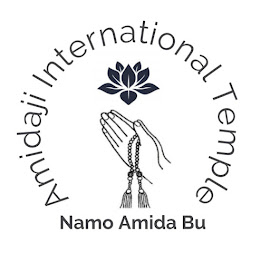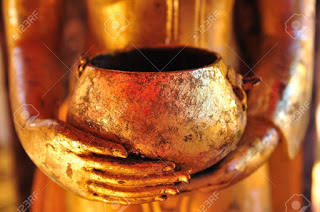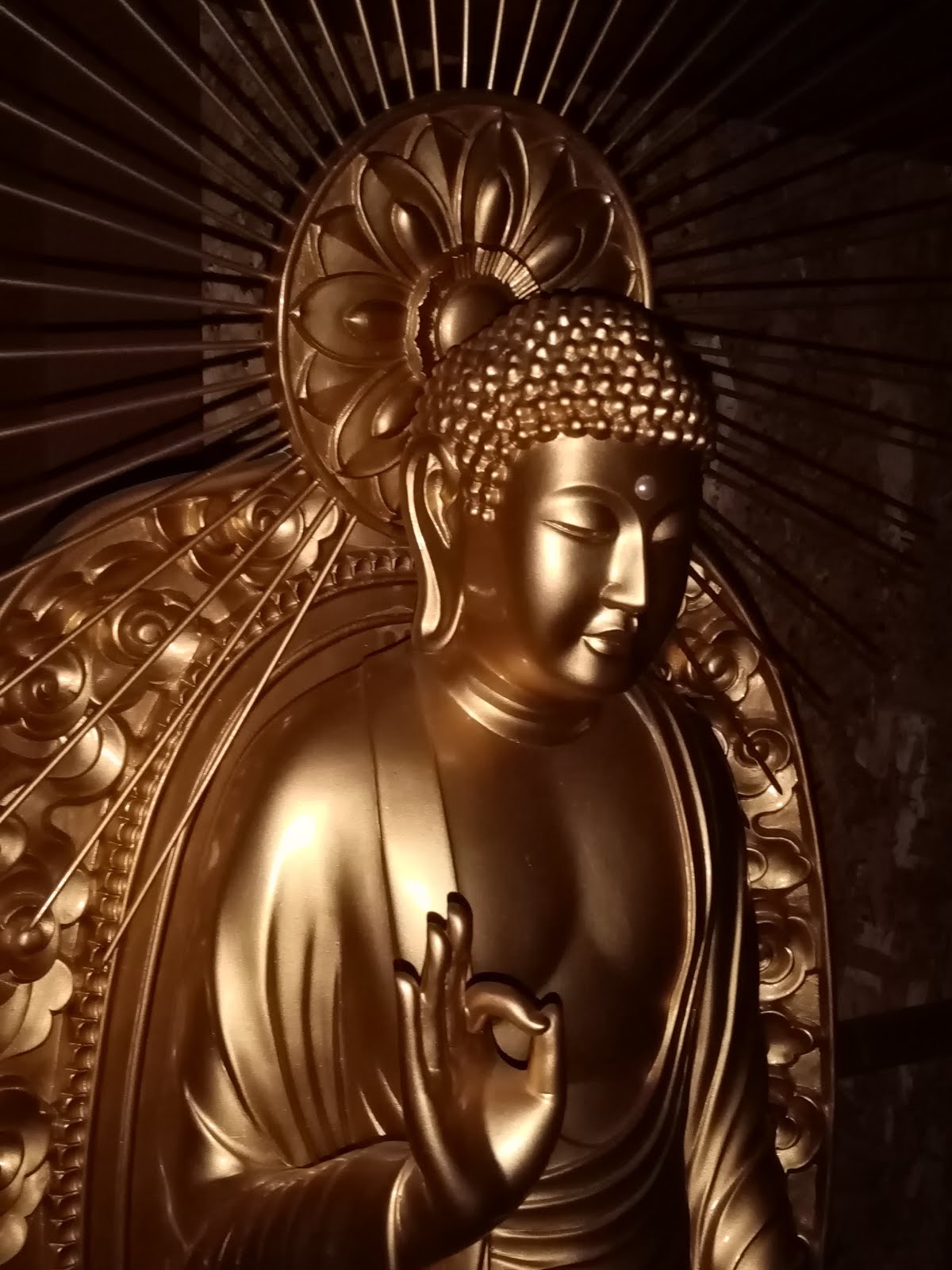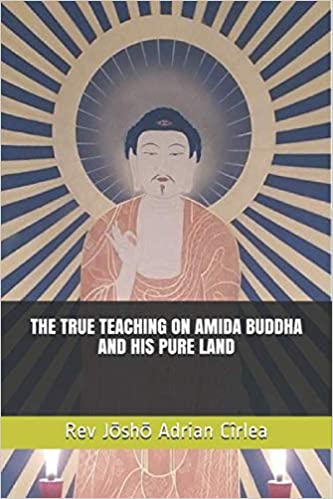last revised: May 23, 2021
In this chapter I will explain
the teaching about the three Dharma ages by using various quotes from the last
chapter of Shinran’s Kyogyoshinsho. These quotes are Master Shinran’s
own words or passages from sutras and commentaries that he himself used in his
explanations.
Generally speaking, the doctrine of the Three Dharma Ages
refers to the gradual decline of the capacities of beings to practice the
Dharma and attain realization through it. Thus, there is a difference between
the time when the Buddha was in a human body and when He influenced directly
through His example and Buddha field those gathered around Him, and the periods
far away in time when only the teaching remains, but not the Teacher.
What a great chance it is to meet a Buddha in flesh and bones and receive instructions directly from Him, being constantly in His presence and influenced by His Buddha field. How quick and safe the spiritual development can be just by seeing His face and having devotion for Him every day, not to mention the constant checking and support He gives to your practice. Also, if you live in the period close to a Buddha’s departure from the physical body (Parinirvana), His influence is still felt and active through the working of His closest disciples or the disciples of these disciples.
As it is stated in the Sutra of Mahamaya:
“During the first five hundred years after the Buddha’s Parinirvana, seven holy monks, sages all, including Mahakasyapa, will uphold the right Dharma in succession so that it does not perish. After five hundred years, the right Dharma will become completely extinct.”
The first period of 500 years after the Buddha’s departure from His physical body (parinirvana) is called the right Dharma age. It is an age characterized by correct understanding and practice of the Dharma in all its aspects (meditation, wisdom and precepts) with the often attainment of emancipation.
The second Dharma age is called the semblance Dharma age, and it lasted 1000 years after the previous one. It was characterized by gradual decadence in the determination by which followers, both monks and lay, practice the Way. Self-indulgence slowly takes place and fills the minds and hearts of the followers. The breaking of precepts becomes more and more common among monks and nuns and “only a few attain the fruit of Enlightenment”.
The third and last Dharma age lasts for 10.000 years after the second age. In it “only the verbal teaching remains”, while nobody is capable of observing the precepts and of truly practicing meditation or other Buddhist methods based on self-power.
Words like, “the right Dharma will become extinct” or
“the teaching will be stored in the naga’s palace”, which can be found
in Mahamaya Sutra, Benevolent King Sutra and Shinran’s works,
means that although one can still find the written texts of the Buddhist
teaching, the practices based on personal power are as good as non-existent or
practically non-existent because nobody can attain Enlightenment through them.
The requirements of the paths of self-power within the Buddhist teachings do
not accord anymore with the capacities of beings. This is the situation in the
last Dharma age.
Also, even though we read about precepts in the sacred
texts, nobody can actually observe them. This is why it is said that in this
period there are no precepts. If there are currently many people who at
least have the capacity to observe precepts in an imperfect manner, we could
say that there is a breaking of precepts, but since people can’t observe
precepts at all, it is said that precepts do not exist anymore. The capacities
of beings in this period are so low that no requirement is made of them, hence there
are no precepts[1].
It is the same as having no pretention of healthy behaviour from a terminally
ill person with a chronic disease.
The matter of accordance between the teaching and the beings to be taught and also the time in which they live in - close or far from the physical presence of the Buddha - is extremely important.
Master Tao-ch’o said that:
“if the beings, the teachings and the times were not in accord, it would be difficult to perform practices and difficult to attain Enlightenment.”
A person living in the presence of the Buddha or close in time to Him can easily follow the paths of self-power practice in comparison with someone living 2500 years distant from the Buddha. The requirements and practices cannot be the same for them because their times and capacities differ.
Master Saicho[2] explained this:
“With regard to the Dharma, there are three ages, and among people, there are three levels. The instruction imparting the teaching and precepts flourishes and declines according to the age, and words of condemnation or praise are accepted or rejected depending on the person... […]
...the wisdom and Enlightenment of beings of the five five-hundred year periods after the Buddha’s demise differ. How can beings be saved by only one path?”
“How can beings be saved by only one path?” - how can beings living in the last Dharma age attain Enlightenment through the means and practices given to those living in the presence of the Buddha or in the right Dharma age, who have a different environment and different capacities?
“It is like rubbing green wood to build a fire; fire cannot be made, for time is not right”, said Master Tao-ch’o in a well suited comparison.
Also Master Shinran said it very clearly:
“Truly we know that the teachings of the Path of Sages were intended for the period when the Buddha was in the world and for the right Dharma-age; they are altogether inappropriate for the times and beings of the semblance and last Dharma-ages and the age when the Dharma has become extinct. Already their time has passed; they are no longer in accord with beings.”
Thus the Great Collection Sutra states:
“Out of billions of sentient beings who seek to perform
practices and cultivate the Way in the last Dharma-age, not one will gain
realization.”
Master Tao-ch’o commented on this last quote by saying:
“This is now the last Dharma-age; it is the evil world of the five defilements. This one gate - the Pure Land way - is the only path that affords passage.”
The Jodo Shinshu path alone doesn’t discriminate between the
capacities of beings and doesn’t depend on the time they live in, whether it is
the period when the Buddha was in the world, the right, semblance and the last
Dharma ages, or the time when the Dharma becomes extinct, because it is the Path
that brings all to perfect Enlightenment, not through their personal power,
which is changeable and not reliable, but through the Other Power of Amida
Buddha.
[1] No requirement in terms of precepts doesn’t mean that people of the last Dharma age should make no efforts in having a moral life or living in harmony with other beings, but that their trying cannot be called observation of precepts anymore. They are not required to attain Enlightenment through leading a pure life and keeping the precepts.
[2] Founder of Tendai. He was quoted by Shinran Shonin in his Kyogyoshinsho.
Jodo Shinshu, the only effective path in this last Dharma age
[1] No requirement in terms of precepts doesn’t mean that people of the last Dharma age should make no efforts in having a moral life or living in harmony with other beings, but that their trying cannot be called observation of precepts, anymore. They are not required to attain Enlightenment through leading a pure life and keeping the precepts.







.jpg)


















0 comentarii:
Post a Comment